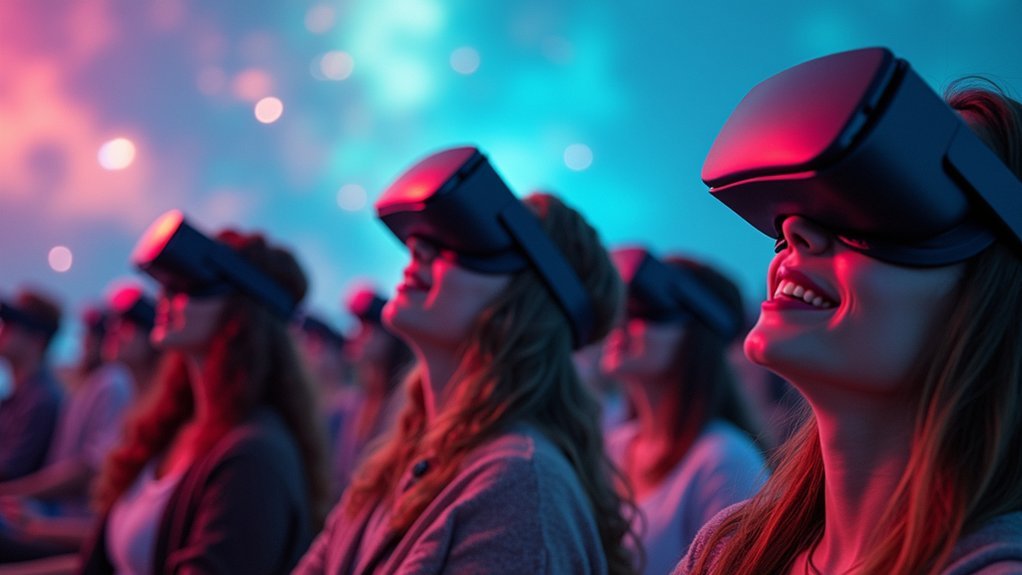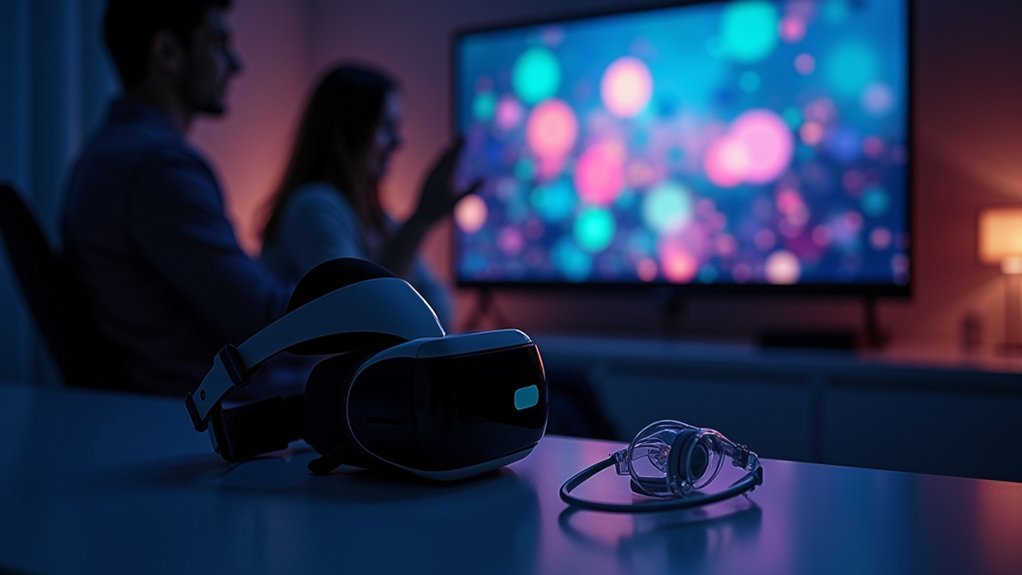Captions in VR experiences guarantee you don’t miss critical dialogue, sound effects, and audio cues that traditional headset usage can obscure. They’re essential for ADA compliance, expanding your market reach to deaf and hard-of-hearing users while benefiting over 80% of users who don’t have hearing impairments. Captions enhance learning retention, clarify complex dialogue, and break down language barriers through real-time translation. With proper implementation, you’ll tap into broader audiences and discover advanced captioning innovations ahead.
Understanding Virtual Reality Accessibility Challenges

While virtual reality promises immersive experiences for all users, it creates significant barriers for deaf and hard of hearing individuals who rely on visual communication methods.
You’ll find that traditional captioning approaches don’t translate effectively into VR environments. When you’re wearing a headset, you can’t simply glance at fixed captions like you’d on a computer screen or television.
The immersive nature of VR means you’re constantly moving your head and looking around, making static caption placement problematic. If you look away from captions in VR, you’ll miss critical dialogue or audio cues entirely.
This creates accessibility issues that developers must address through innovative solutions. Current captioning practices need significant adaptation to guarantee captions in VR provide equal access to content for all users.
The Essential Role of Captions in Immersive Environments
When you’re exploring VR environments, captions don’t just accommodate hearing differences—they break down communication barriers that can exclude entire user groups from participating in immersive experiences.
You’ll find that captions dramatically improve your learning retention by engaging multiple sensory channels, allowing you to process audio and visual information simultaneously for deeper comprehension.
Beyond user benefits, you’re also addressing legal compliance requirements that mandate accessible design, ensuring your VR applications meet accessibility standards and avoid potential litigation.
Breaking Communication Barriers
As you enter a virtual reality environment, captions become your bridge to full participation, transforming what could be an isolating experience into an inclusive one. When you’re deaf or hard-of-hearing, captions guarantee you don’t miss essential audio cues that drive the narrative forward.
You’ll find these accessibility features clarify complex dialogue and technical jargon, making content comprehensible regardless of your hearing ability or language background.
What’s remarkable is that you’re not alone in benefiting from captions – over 80% of users who rely on them don’t have hearing impairments. Whether you’re learning English as a second language or simply want better understanding of intricate content, captions enhance your comprehension and retention, making virtual experiences truly accessible for everyone.
Enhanced Learning Retention
Beyond accessibility benefits, captions dramatically boost your learning retention in virtual reality environments. When you read along with audio content, you’ll experience improved comprehension and retention rates that make VR learning incredibly effective.
You’ll find captions particularly valuable for grasping complex terms and jargon that frequently appear in virtual educational scenarios.
Research shows 98% of students find captions helpful for understanding and recalling information. What’s surprising is that 80% of caption users don’t have hearing impairments—they simply recognize how captions reinforce audio and visual content.
You’ll also appreciate how captions help you focus better by combating background noise distractions, especially when you’re learning in sound-sensitive environments like libraries or shared spaces.
Legal Compliance Requirements
While immersive technology continues advancing rapidly, you’ll need to guarantee your virtual reality experiences comply with federal accessibility laws. The Americans with Disabilities Act requires organizations to provide accessible content, including captions for users with hearing impairments.
Without proper captioning, you’re risking significant legal repercussions and potential lawsuits that could damage your organization’s reputation.
Legal compliance isn’t just about avoiding penalties—it’s about demonstrating your commitment to inclusivity. When you implement captions in VR experiences, you’re expanding your market reach to include deaf and hard-of-hearing users.
This accessibility approach enhances user engagement and satisfaction across all demographics. Research confirms that effective captioning creates equitable access to immersive experiences, supporting your compliance efforts while building a more diverse, inclusive audience for your virtual reality content.
Breaking Down Language Barriers in VR Experiences
When you’re experiencing virtual reality content in a language that isn’t your native tongue, closed captions become powerful tools that transform potentially confusing experiences into accessible ones.
Closed captions in VR transform language barriers from obstacles into opportunities for truly inclusive immersive experiences.
These captions effectively break down language barriers by providing real-time translated text for spoken dialogue, ensuring you don’t miss essential information during immersive experiences.
You’ll find captions particularly helpful when encountering regional accents and dialects that might otherwise hinder your comprehension.
As an ESL participant, you can follow along seamlessly with presentation content through simultaneous translation features.
Research shows that 80% of caption users don’t have hearing impairments, demonstrating their widespread value for language comprehension.
Accommodating Deaf and Hard of Hearing Users

Closed captions serve an even more fundamental purpose for deaf and hard of hearing (DHH) users, who represent approximately one in six people in the U.S. experiencing some degree of hearing loss. For these users, captions aren’t just helpful—they’re essential for accessing vital audio information and following VR narratives that would otherwise be completely missed.
Research shows that most DHH participants feel comfortable using live captions in VR, markedly improving their comprehension and engagement in immersive environments.
You’ll also need to take into account accessibility standards like the Americans with Disabilities Act (ADA) to guarantee your VR content remains inclusive and legally compliant.
Additionally, offering customizable caption settings allows DHH users to adjust positioning and styles according to their preferences, further enhancing their overall VR experience.
Visual Reinforcement for Enhanced Comprehension
You’ll discover that reading captions while listening to audio dramatically improves your understanding of VR content, even if you don’t have hearing difficulties.
Captions help you catch technical jargon, proper names, and specialized terminology that might otherwise slip past during immersive experiences.
This visual text reinforcement strengthens your memory retention, making complex VR educational content stick with you long after the session ends.
Reading Improves Audio Understanding
Although you might expect captions to serve primarily those with hearing difficulties, research reveals that 80% of closed caption users don’t have hearing impairments at all.
Reading along with audio creates a dual-processing system that enhances your comprehension and retention considerably.
When you’re experiencing VR content with captions, your user experience improves through multiple reinforcement channels:
- Technical clarity – Complex jargon, character names, and brand terminology become instantly clear
- Cognitive support – Visual reinforcement reduces mental load during information-heavy sequences
- Enhanced engagement – You’re 80% more likely to complete captioned content
This visual-audio combination proves especially valuable in immersive VR environments where spatial audio and complex narratives can overwhelm your processing capacity.
Captions transform challenging content into accessible, engaging experiences.
Captions Clarify Technical Terms
Technical terminology poses a unique challenge in VR environments, where specialized vocabulary can quickly overwhelm your understanding.
Captions provide essential visual reinforcement by clarifying these complex terms and jargon, making educational VR experiences more accessible. When you encounter unfamiliar concepts, captions guarantee key terms are easily identifiable, considerably aiding your retention and comprehension regardless of your subject matter familiarity.
Research shows that 98% of students find captions useful for learning, particularly when dealing with specialized vocabulary in immersive settings.
Visual Text Boosts Retention
When you combine visual text with audio in VR environments, your brain processes information through multiple channels simultaneously, creating stronger neural pathways that remarkably improve retention rates. This dual-processing approach leverages your visual and auditory systems, making the immersive experience more memorable and effective.
Research confirms that 98% of students find captions beneficial for learning, while simultaneous reading and listening greatly enhances comprehension. In VR, this translates to:
- Increased engagement – You’re more likely to stay focused when captions accompany audio
- Better information processing – Complex technical terms become clearer through visual reinforcement
- Enhanced memory formation – Multiple sensory inputs create stronger recall pathways
Even if you don’t have hearing impairments, captions in your VR experience will boost understanding and retention considerably.
Combating Audio Interference and Environmental Noise
Environmental noise and audio interference can quickly derail your virtual reality experience, making captions an indispensable feature for maintaining immersion and comprehension. You’ll encounter numerous situations where background sounds compete with VR audio content, from noisy roommates to construction work outside your window.
| Environment Challenge | Caption Solution |
|---|---|
| Public transportation noise | Visual dialogue backup |
| Household distractions | Complete audio alternative |
| Sound-sensitive locations | Silent viewing option |
When you’re wearing a VR headset in libraries or shared spaces, captions enhance accessibility by eliminating audio dependency entirely. Studies demonstrate that 85% of users rely on visual text when audio clarity becomes compromised. By incorporating captions, you’ll maintain focus on critical narrative elements without missing essential information, ensuring your virtual experience remains engaging regardless of environmental interference.
Legal Compliance and Accessibility Standards in VR

Beyond environmental considerations, you’ll face mandatory legal obligations that require accessible VR content in many jurisdictions.
Legal compliance with the Americans with Disabilities Act (ADA) makes captions essential for avoiding costly litigation and reputational damage. Organizations failing to meet accessibility standards risk significant legal repercussions while alienating users with hearing disabilities.
Implementing captions in VR environments provides three critical benefits:
- Legal Protection – Prevents discrimination lawsuits and guarantees compliance with federal accessibility requirements
- Market Expansion – Opens your content to deaf and hard-of-hearing users, broadening your potential audience
- Professional Reputation – Demonstrates commitment to inclusive design and corporate social responsibility
Meeting accessibility standards isn’t optional—it’s a business necessity that protects your organization while creating equitable digital experiences for all users.
Caption Placement Strategies in 3D Spaces
Establishing legal compliance sets the foundation, but successfully implementing captions requires mastering their placement within three-dimensional virtual environments.
You’ll need to contemplate user perspective and movement patterns to guarantee visibility without obstructing critical visuals. Traditional flat captioning methods won’t work in immersive experiences where information can easily be missed.
Anchor your captions to specific objects or characters within the virtual world. This maintains relevance and helps users associate text with corresponding audio cues.
Object-anchored captions create seamless audio-visual connections, ensuring users naturally link spoken dialogue with its source in three-dimensional space.
Implement dynamic adaptation so captions move with your gaze, preventing confusion and VR sickness. Research shows headlocked and lag captions outperform static options for user-friendliness.
Reflect on adding guidance mechanisms that notify you when you’re looking away from referenced objects, assuring you won’t miss critical information.
Technical Implementation of VR Captioning Systems
When you’re building VR captioning systems, you’ll need to establish precise positioning methods that account for 3D spatial relationships and user movement patterns.
Your implementation must synchronize audio tracks with caption delivery through specialized tools like XR Access’s Chirp system, which integrates seamlessly into Unity projects.
You’ll also want to provide robust customization options that let users adjust font size, color, and positioning preferences to match their individual accessibility needs.
Caption Positioning Methods
As you design VR captioning systems, you’ll need to choose between two primary positioning methods that fundamentally affect user experience.
Caption positioning methods in VR applications fall into two distinct categories: headlocked and contextual placement.
Headlocked captions remain fixed relative to your viewpoint, moving with your head movements. This approach prevents VR sickness in dynamic environments since captions maintain consistent positioning.
Contextual captions anchor to specific objects or characters within the virtual space, creating more immersive experiences but potentially causing discomfort during rapid scene changes.
Consider these implementation strategies:
- Dynamic adaptation – Adjust caption behavior based on user gaze patterns
- Focus tracking – Monitor where you’re looking to guarantee visibility
- Pre-scripted accuracy – Use predetermined text over auto-generated captions for better comprehension
Audio Synchronization Systems
Beyond positioning captions effectively, you must guarantee they sync perfectly with audio content to maintain immersion and comprehension. Audio synchronization systems form the technical backbone of VR captioning, ensuring real-time display of text alongside spoken dialogue.
| Implementation Method | Technical Tool | File Format |
|---|---|---|
| Script Integration | CaptionSource in Unity | SRT files |
| Real-time Processing | Audio playback linking | Timestamp data |
| Dynamic Adjustment | Gaze tracking systems | JSON metadata |
| Quality Assurance | Synchronization testing | Caption databases |
You’ll need to generate SRT files for your audio clips, then import them into Unity for precise timing control. The captions must dynamically adjust based on user movement and gaze direction, preventing missed audio cues. Thorough testing prevents timing discrepancies that could confuse users and break immersion.
User Customization Options
How can you guarantee your VR captioning system serves users with diverse accessibility needs and preferences? You’ll need robust user customization options that put control directly in users’ hands.
Modern captioning systems should offer thorough personalization features that adapt to individual requirements.
Your VR caption interface should include these essential customization elements:
- Visual Controls – Font size, color schemes, and text weight adjustments for ideal readability
- Positioning Options – Flexible caption placement within the virtual environment to prevent visual obstruction
- Language Settings – Multi-language support with seamless switching capabilities for diverse audiences
Transparent backgrounds help integrate captions naturally into virtual environments while maintaining text clarity.
When you implement user-friendly customization interfaces, you’re empowering users to create personalized experiences that enhance engagement and satisfaction across your VR content.
User Customization Options for VR Captions
While virtual reality environments offer immersive experiences, they can exclude users who need captions if customization options aren’t available. User customization options guarantee individuals with hearing impairments can fully participate by adjusting font size, color, and positioning to match their specific needs and preferences.
Customizable captions in VR ensure hearing-impaired users can fully experience immersive environments through personalized font, color, and positioning adjustments.
You’ll benefit from controlling subtitle display settings like transparency and background color, which help integrate captions seamlessly without obstructing important visual elements. Multiple language support expands accessibility for non-native speakers, while intuitive settings menus make customization straightforward for all users.
Auto-subtitle generators streamline the development process, enabling creators to provide accurate, timely captions more efficiently.
These extensive customization features encourage broader VR adoption by accommodating diverse user requirements and guaranteeing everyone can engage meaningfully with virtual content.
Best Practices for VR Caption Design and Timing
Effective VR caption design demands careful attention to readability fundamentals that guarantee accessibility across diverse virtual environments. You’ll need high-contrast colors and readable fonts to make sure captions remain visible against varying backgrounds.
Strategic positioning keeps text within your field of view without obstructing vital visual elements. Timing synchronization proves equally essential for maintaining immersion.
Consider these important practices:
- Align captions with audio cues – Match subtitle appearance to spoken dialogue and environmental sounds for seamless integration.
- Use transparent backgrounds – Allow virtual elements to show through while maintaining text legibility.
- Enable real-time customization – Provide users control over font size, color, and positioning preferences.
These approaches enhance accessibility while preserving the immersive quality that makes VR experiences compelling. Proper implementation guarantees captions support rather than hinder user engagement.
Market Benefits of Accessible VR Content
Beyond creating better user experiences, accessible VR content delivers substantial financial returns that make captioning a smart business investment.
You’ll tap into a rapidly expanding market projected to reach $1.5 trillion by 2030, where captioned content can boost viewership by 7-40% and drive 16% more revenue.
The market benefits extend beyond compliance with ADA requirements.
You’re attracting diverse audiences, including the 85% of users who watch content without sound on platforms like Facebook.
Your accessible VR content demonstrates inclusivity, expanding your customer base while enhancing user retention.
With 98% of students finding captions useful for learning, you’ll improve educational outcomes and build stronger customer loyalty, positioning your organization competitively in this growing sector.
Future Developments in VR Caption Technology
As VR technology evolves, caption systems are becoming increasingly sophisticated to match the complexity of immersive environments.
You’ll soon experience dynamic captioning that adapts to your movements and interactions, making accessibility seamless within virtual worlds.
Advanced algorithms will track your gaze direction and spatial awareness, ensuring you never miss critical information.
Here’s what’s coming:
- AI-driven speech recognition – You’ll get more accurate live captioning that understands context, reducing dependence on pre-scripted text
- Customizable display options – You’ll control font size, color, and positioning to match your individual preferences and needs
- Integrated design guidelines – Developers will build accessibility features into VR experiences from the start, not as afterthoughts
These developments will transform how you interact with VR content.
Frequently Asked Questions
What Is the Point of Captions?
You’ll find captions break down barriers by making content accessible to deaf users, helping non-native speakers understand better, and improving comprehension even when you can’t hear audio clearly.
Why Is Virtual Reality Important in Points?
You’ll benefit from VR’s immersive experiences that transform education, healthcare, and entertainment. It creates interactive 3D environments, enhances training programs, and opens new commercial opportunities worth trillions in market value.
Why Are People Interested in Virtual Reality?
You’re drawn to virtual reality because it lets you experience immersive worlds, escape physical limitations, and engage with content in unprecedented ways that traditional media can’t match, offering exciting possibilities for entertainment, learning, and social interaction.
Is Virtual Reality Going to Be Important in Entertainment?
You’ll see VR become entertainment’s powerhouse as the market reaches $57.55 billion by 2027. Major companies like Disney and Netflix are already investing heavily, creating unforgettable experiences that’ll revolutionize how you consume media.





Leave a Reply